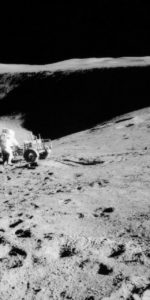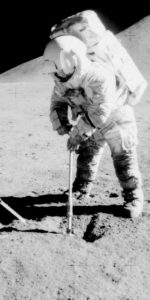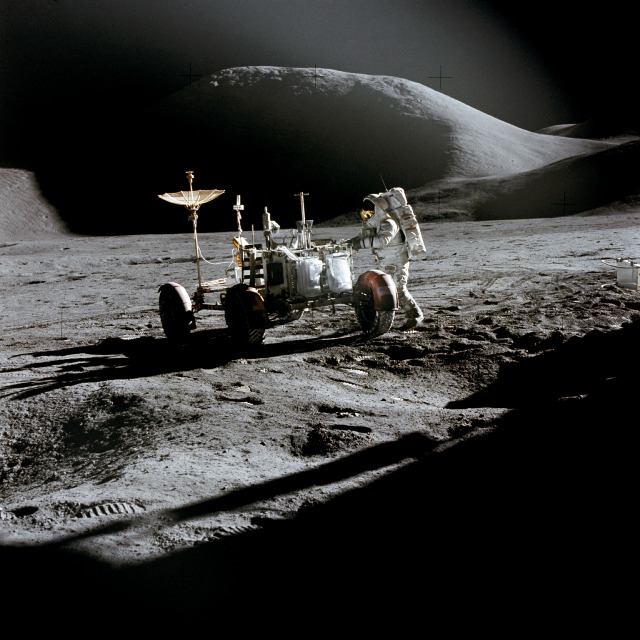
Forty-five years ago, this week, as July burned into August 1971, three sons of Planet Earth were midway through their exploration of the Moon. Aboard the Command and Service Module (CSM) Endeavour, astronaut Al Worden operated a sophisticated array of scientific equipment from orbit, whilst his Apollo 15 crewmates Dave Scott and Jim Irwin were on the surface at a place called Hadley—a mountainous region, 400 miles (640 km) north of the lunar equator, characterized by spectacular peaks, football-field-sized craters, and a 25-mile-long (40-km) gorge, known as Hadley Rille. As outlined in last week’s AmericaSpace history articles, the discoveries made by Apollo 15 revealed more about the history and evolution of the lunar highlands than ever before and their effects continue to resonate to this day.
Early on 1 August, Capcom Gordon Fullerton woke Scott and Irwin with some unwelcome news. Two days earlier, the Lunar Module (LM) Falcon had touched down at a slight angle—one of its legs had set down in a crater—and this had caused it to lose a sizeable amount of water. Fullerton asked the men to check behind the LM’s barrel-like ascent engine cover. He was right, and the astronauts quickly scooped it into a spent lithium hydroxide canister.
Scott and Irwin’s second Moonwalk was slightly shorter than their first, in order to provide more exploration and less traveling time between geological stops. One relatively low-priority activity had been eliminated and a greater measure of freedom was given to the efforts of the astronauts; Mission Control and the geologists at the Manned Spacecraft Center (MSC) in Houston, Texas, would depend heavily upon their descriptions and observations, and it would be Scott and Irwin’s choice on exactly where they chose for their major sampling. “We’re looking now, primarily, for a wide variety of rock samples from the [Apennine] Front,” Capcom Joe Allen told them. “You’ve seen the breccias already. We think there may very well be some large crystal[line] igneous [rocks] and we’d like samples of those and whatever variety of rocks which you’re able to find for us—but primarily a large number of documented samples and fragment samples.” Scott was in full agreement; Allen was talking their language, and after two years of geological training he felt ready and confident to explore.
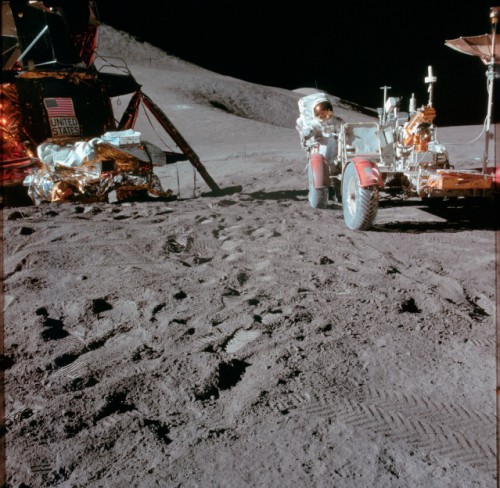
A few minutes before 9 a.m. EDT on 1 August 1971, safely buckled aboard the first battery-powered Lunar Roving Vehicle (LRV), the astronauts set off due south, heading for Mount Hadley Delta, upon whose slopes they would concentrate their energies. It was a scenic trip, Irwin recalled in his memoir, To Rule the Night. Ahead of them, and all around them, the terrain was splattered with craters, right up the slopes of Hadley Delta, and the height of the mountain rivaled the tallest peaks of the Rockies. After passing the vast cavity of Dune Crater, whose rim was littered with large blocks, they started up the mountain. On the plain the going had been rough, but on the slope the surface smoothed out markedly. Near Spur Crater, they swung left and drove across-slope.
Looking downslope, they were astonished to realise how far they had come. The lander was a tiny speck on the undulating plain, and the astronauts were now at an elevation of about 350 feet (106 meters). And the view, completely unhindered by atmosphere or haze, almost knocked Dave Scott’s socks off.
Their first task was to find a small “drill hole” crater that could have excavated material from the mountain, but the flank was remarkably clean. Scott curtailed the planned drive, and they sampled a small crater and then an isolated boulder which was coated in greenish material. The green hue captivated Jim Irwin, whose Irish descent and birthday on St. Patrick’s Day—and the fact that he had stowed some shamrocks in the lunar module—made this a special find. At first, the two men wondered if their eyes or Sun visors were playing tricks on them, but when it was unpacked a few weeks later in the Lunar Receiving Laboratory (LRL), their initial impressions would be confirmed: It was green, made entirely of minuscule spheres of glass, tiny droplets of magma spewed from a fissure by a “fire fountain.” In time, it and other samples would contribute to making Apollo 15 one of the greatest voyages of discovery ever undertaken in human history.
Finally, they headed for Spur Crater. “As soon as we got there,” Irwin wrote, “we could look over and see some of this white rock. Immediately, I saw white, I saw light green and I saw brown. But there was one piece of white rock that looked different from any of the others. We didn’t rush over to it; we went about our job the usual way. First I took down-Sun shots and a locator shot about 45 degrees from the Sun-line and Dave took a couple of cross-Sun shots.” They threaded their way between the craters to the strange white rock. “It was lifted up on a pedestal,” Irwin wrote. “The base was a dirty old rock covered with lots of dust that sat there by itself, almost like an outstretched hand. Sitting on top of it was a white rock almost free of dust. From four feet away I could see unique long crystals with parallel lines, forming striations.” Scott used tongs to pick it up and held it close to his visor to inspect it. The rock was about the same size as his fist and even as he lifted it, some of its dusty coating crumbled away … and he saw large, white crystals.
“Aaaahh!” he exulted.
“Oh, man!” added Irwin.
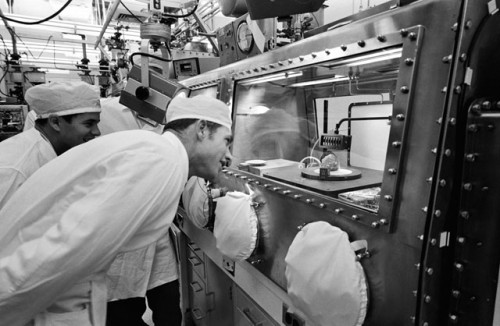
The rock was almost entirely “plagioclase”—an important tectosilicate feldspar mineral used by petrologists on Earth to help determine the composition, origin, and evolution of igneous rocks—and from their expeditions into the hills of the San Gabriels, Scott recognized it as “anorthosite,” which is the purest form of plagioclase. For some time, lunar geologists had suspected that anorthosite formed the Moon’s original, primordial crust; indeed, data from the unmanned Surveyor 7 lander had suggested its presence in the ejecta of the crater Tycho, and tiny fragments of it had actually been found in samples from both Apollo 11’s landing site at Tranquility Base and Apollo 12’s site in the Ocean of Storms.
“Explaining why most of the Moon’s crust should be composed of anorthosite,” wrote Andrew Chaikin in A Man on the Moon, “led some geologists to an extraordinary scenario. Within the infant satellite, they proposed, there was so much heat that the entire outer shell became an ocean of molten rock. As this ‘magma ocean’ cooled, minerals crystallized. The heavier species, including the iron- and magnesium-rich crystals, sank to the bottom. The lighter crystals, specifically, the mineral [aluminium-rich] plagioclase floated to the top.”
Recognizing the find as probably a piece of the Moon’s primordial crust, Scott could hardly contain his enthusiasm. “Guess what we just found!” he radioed. “I think we just found what we came for!”
“Crystalline rock, huh?” said Irwin.
“Yessir,” replied Scott.
After briefly describing the rock’s appearance, Scott placed it into a sample bag by itself. It would be labeled as sample number 15415, but a keen journalist, inspired by the term “petrogenesis”—the study of the origin of igneous rocks—would later offer it a far loftier title: “The Genesis Rock,” a sample of the original lunar crust, coming from one of the earliest epochs of the Moon’s history, some 4.1 billion years ago. This date was reached by geologists at the University of New York at Stony Brook and proved to be almost 1.5 billion years older than the oldest rocks found on Earth. If the Moon was any older than that, noted Chaikin, it wasn’t much older; the Solar System itself was thought to have formed only a few hundred million years earlier.
Back in the vicinity of Falcon, shortly before 2 p.m. EDT and five hours into their second Moonwalk, Scott and Irwin had other chores to finish. Firstly, there was the need to complete drilling the heat-flow hole which had hit resistant soil the previous day. Scott had already noticed inside the LM that his injured fingers were starting to turn black and so had to summon as much strength as he could muster—bringing his hands right up close to his chest just to squeeze the drill’s trigger—to complete the task. He could physically stand only about a minute of the pressure on his fingernails, before breaking off for a breather. At length, both sensor packages were in place to a depth of about 5 feet (1.5 meters). However, when Scott attempted to extract the core sample which, at about 8 feet (2.4 meters) long, was the deepest such sample yet attempted on the Moon, he managed to lift it slightly, but it refused to budge any further. Joe Allen told him to leave it until tomorrow’s final excursion.
Meanwhile, Irwin dug a trench and used a penetrometer to test the bearing strength of its walls and floor. “If you think digging a ditch is dog’s work on Earth,” he wrote, “try digging a ditch on the Moon. The big limitation is the suit and the fact that you are clumsy at one-sixth-G. I had practiced on Earth and come up with a technique that most dogs use. You spread your legs and push the dirt between them. I solved a dog’s job with a dog’s technique. This method worked perfectly on the Moon.” He easily dug through a fine material, like talcum powder, and then a coarser, darker soil, but had to give up on reaching a very resistant layer which, although it looked moist, had the consistency of hardpan.
They wrapped up the second Moonwalk by planting the American flag and loading that day’s rock box aboard Falcon. Not only had most of the equipment operated flawlessly, but the live—and color—images provided by the Earth-operated television camera on the rover was a far cry from the crude black-and-white pictures of Apollo 11. Furthermore, Scott and Irwin had truly done their mentor, Lee Silver, proud through their geological descriptions. “I’m told,” Joe Allen radioed, “that we checked off the 100-percent science completion square time during EVA-1 or maybe even shortly into EVA-2. From here on out, it’s gravy all the way!”
The final part of this four-part article will appear tomorrow.
Want to keep up-to-date with all things space? Be sure to “Like” AmericaSpace on Facebook and follow us on Twitter: @AmericaSpace




